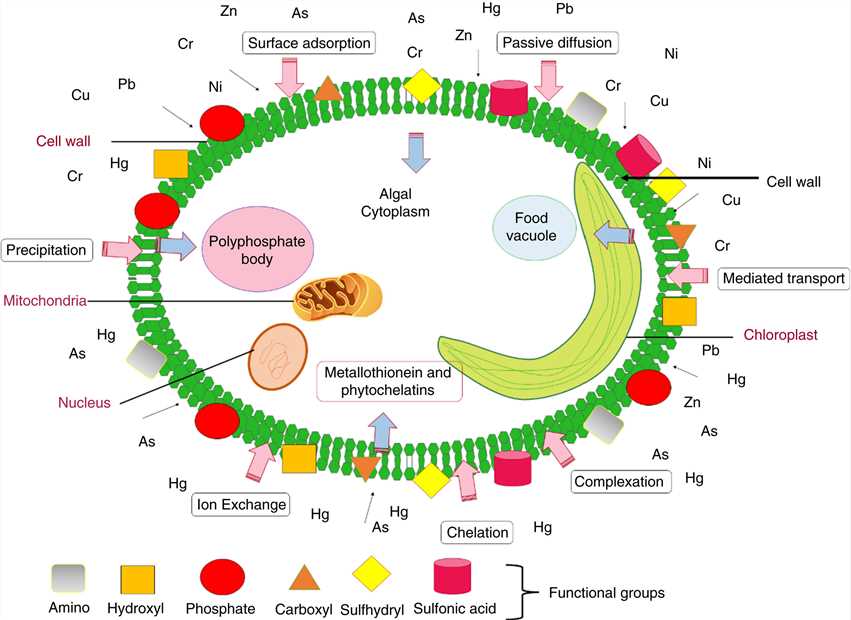Heavy metal (HM) pollution of water bodies is a serious global environmental problem. Bioremediation of wastewater using microalgae is less costly, more energy efficient, and more effective in reducing pollutants than conventional wastewater treatment technologies. Here, Lifeasible offers specialized solutions for the genetic engineering of microalgae for bioremediation.
Natural water bodies worldwide are contaminated with different types of heavy metals, and industrial wastewater is discharged directly or indirectly. These heavy metals are toxic, persistent, and non-degradable and have a negative impact on the biosphere. Removing these inorganic pollutants from the aqueous environment by biological processes is popular for their cost-effectiveness and efficiency compared to traditional physicochemical methods. Microalgae are a promising tool for heavy metal remediation due to their unique advantages. Microalgal cells can absorb heavy metals through different physiological and biological approaches and are used as nutrient sources to regulate their metabolic processes to produce biomass. Moreover, various strategies can be used to improve heavy metal removal efficiency, such as immobilization of algal cells, development of algal aggregates, and design of microalgae-based nanocomposites. However, poor biomass productivity under abiotic stress conditions hinders the large-scale deployment of microalgae.
 Fig 1. Mechanisms of heavy metal uptake in microalgae. (Goswami R K et al., 2022)
Fig 1. Mechanisms of heavy metal uptake in microalgae. (Goswami R K et al., 2022)
Based on our cutting-edge microalgal genetic engineering platform and abundant molecular tools for genome editing, our scientists can quickly tailor the design of microalgal cell factories to enhance the microalgal removal of different pollutants for many final or starting products. Lifeasible focuses on increasing the potential of transgenic microalgae in these areas by genetically engineering them to manipulate microalgal detoxification mechanisms.
We aim to genetically transform specific genes and traits related to the following to improve the bioremediation of heavy metals by microalgae.
At least 11 unique gene families in the microalgal genome encode metal transport proteins. We have genetically modified a variety of metal transporter proteins for the phytoremediation of HMs, including NRAMP, ZRT, IRT, ZIP, FTR, etc.
We genetically engineer microalgae to overexpress some metal-binding organic molecules to reduce the toxic effects of HMs and process them as chelate complexes for storage in organelles or plasma membranes.
Exogenous or endogenous chemicals in cells are metabolized by biotransformation to less toxic products. We reduce the toxicity of HMs in microalgae by encoding enzymes for their detoxification pathways.
HMs induce the production of reactive oxygen species. We efficiently convert superoxide radicals by upregulating genes encoding several antioxidant enzymes (superoxide dismutase (SOD), peroxidase (POD), catalase (CAT), guaiacol peroxidase (GPX), and glutathione s-transferase (GST)) in microalgae cells.
We genetically modified the main regulators of the metal stress response (TF, phytohormones, and miRNAs) in microalgae to minimize the adverse effects of HMs.
Adsorption of metal ions by the cell wall and other extracellular components of microalgae plays an important role in reducing the effects of toxins. We can effectively modify the metal adsorption properties of the cell surface to improve the HM phytoremediation capacity and specificity of microalgae.
(1) Design.
(2) Construct.
(3) Test.
(4) Learning Cycle.
At Lifeasible, we can quickly help you enhance the ability of microalgae to remove multiple heavy metals (Mn, Fe, Cu, Zn, As, Cd, Hg, and Pb) from wastewater. We are your trusted partner in all aspects of microalgae research. If you are interested in our solutions for the genetic engineering of microalgae for biofuels production, please do not hesitate to contact us.
Reference
Lifeasible has established a one-stop service platform for plants. In addition to obtaining customized solutions for plant genetic engineering, customers can also conduct follow-up analysis and research on plants through our analysis platform. The analytical services we provide include but are not limited to the following:
STU-CRISPR System Improves Plant Genome Editing Efficiency
April 19, 2024
Application of Exosomes in Facial Beauty
April 12, 2024